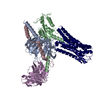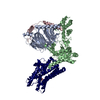+Search query
-Structure paper
| Title | A neurodevelopmental disorder mutation locks G proteins in the transitory pre-activated state. |
|---|---|
| Journal, issue, pages | Nat Commun, Vol. 15, Issue 1, Page 6643, Year 2024 |
| Publish date | Aug 5, 2024 |
 Authors Authors | Kevin M Knight / Brian E Krumm / Nicholas J Kapolka / W Grant Ludlam / Meng Cui / Sepehr Mani / Iya Prytkova / Elizabeth G Obarow / Tyler J Lefevre / Wenyuan Wei / Ning Ma / Xi-Ping Huang / Jonathan F Fay / Nagarajan Vaidehi / Alan V Smrcka / Paul A Slesinger / Diomedes E Logothetis / Kirill A Martemyanov / Bryan L Roth / Henrik G Dohlman /  |
| PubMed Abstract | Many neurotransmitter receptors activate G proteins through exchange of GDP for GTP. The intermediate nucleotide-free state has eluded characterization, due largely to its inherent instability. Here ...Many neurotransmitter receptors activate G proteins through exchange of GDP for GTP. The intermediate nucleotide-free state has eluded characterization, due largely to its inherent instability. Here we characterize a G protein variant associated with a rare neurological disorder in humans. Gα has a charge reversal that clashes with the phosphate groups of GDP and GTP. As anticipated, the purified protein binds poorly to guanine nucleotides yet retains wild-type affinity for G protein βγ subunits. In cells with physiological concentrations of nucleotide, Gα forms a stable complex with receptors and Gβγ, impeding effector activation. Further, we demonstrate that the mutant can be easily purified in complex with dopamine-bound D2 receptors, and use cryo-electron microscopy to determine the structure, including both domains of Gα, without nucleotide or stabilizing nanobodies. These findings reveal the molecular basis for the first committed step of G protein activation, establish a mechanistic basis for a neurological disorder, provide a simplified strategy to determine receptor-G protein structures, and a method to detect high affinity agonist binding in cells. |
 External links External links |  Nat Commun / Nat Commun /  PubMed:39103320 / PubMed:39103320 /  PubMed Central PubMed Central |
| Methods | EM (single particle) |
| Resolution | 3.2 - 3.28 Å |
| Structure data | EMDB-41766: CryoEM structure of D2 dopamine receptor in complex with GoA KE mutant, scFv16, and dopamine EMDB-41776, PDB-8u02: |
| Chemicals |  ChemComp-LDP: |
| Source |
|
 Keywords Keywords | MEMBRANE PROTEIN / GPCR / Dopamine / DRD2 / Dominant Negative |
 Movie
Movie Controller
Controller Structure viewers
Structure viewers About Yorodumi Papers
About Yorodumi Papers







 homo sapiens (human)
homo sapiens (human)
